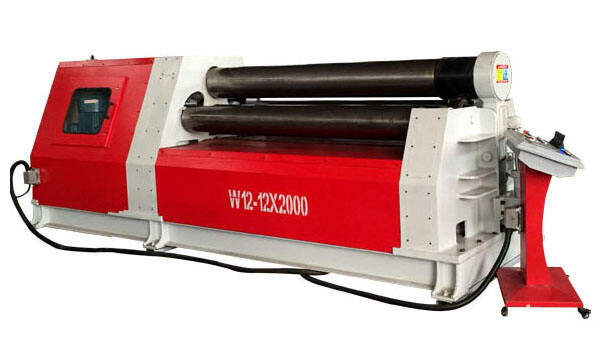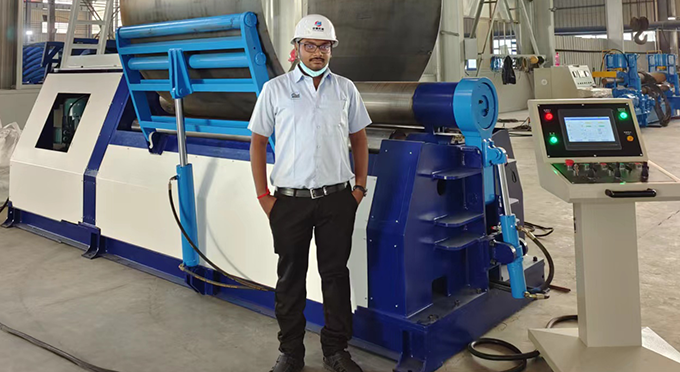The Evolution of Three-Roll Plate Rolling Machines
From Traditional to CNC-Enhanced Designs
In the early days of the industrial revolution, three-roll plate rolling machines were introduced as a revolutionary improvement for shaping metal sheets into cylindrical forms. These machines consisted of three rolls configured in a pyramid or triangle format, allowing even inexperienced operators to manipulate metal sheets with ease. However, the introduction of CNC technology has brought significant advancements in operation precision. CNC-enhanced designs now offer refined control over the rolling process, enhancing both efficiency and production quality. Companies implementing CNC technology in their plate rolling machines have observed a noticeable reduction in labor costs and improved efficiency, translating to increased return on investment. According to industry statistics, CNC technology can enhance operational efficiency by up to 40%, which is a testament to the transformative power of modern engineering solutions in metalworking.
Comparing Three-Roll vs. Four-Roll Configurations
When deciding between three-roll and four-roll plate rolling machines, it is essential to consider the mechanical differences that set these configurations apart. Three-roll machines are typically favored for applications requiring tight radius bending, offering a more straightforward mechanism in comparison to four-roll configurations. The three-roll design provides more direct manipulation of the metal, making it suitable for custom or smaller-scale projects where flexibility is paramount. On the other hand, four-roll configurations often hold an advantage in ease of automation and precision, due to the additional roll that aids in the continuous control of the plate material. Industry experts suggest that while three-roll machines excel in versatility and are well-suited for tight spaces, four-roll machines offer superior ease of use for more extensive, standardized production processes. Deciding the best fit for a project depends largely on the specific operational needs and the desired outcomes in terms of production volume and material characteristics.
Key Innovations in Modern Three-Roll Plate Rolling Machine Design
Advanced Material Compatibility for Diverse Applications
The evolution of plate rolling machines has expanded their capability to process a variety of materials, enhancing their versatility in industrial applications. Metals such as steel, aluminum, copper, and titanium are commonly rolled, each with unique properties such as varying tensile strengths and ductility levels. These advancements in machine design have widened capabilities, allowing for greater adaptability in processing different materials. For example, the incorporation of stronger frames and improved rollers have made it easier to manipulate high-strength materials without compromising on quality. Industry case studies highlight how modern machines have doubled material utilization efficiency, allowing manufacturers to switch between materials seamlessly while maintaining precision and quality.
Precision Engineering for Complex Curvatures
Precision engineering within modern three-roll plate rolling machines has allowed the creation of complex shapes with tight tolerances. Engineering principles such as direct force application and digital control systems enable the formation of intricate curves in metal sheets. Applications requiring complex designs include the aerospace and automotive sectors, where precise bending is crucial for components like turbine blades and vehicle frames. Engineers emphasize that achieving design goals with precision engineering requires a combination of advanced control systems and robust mechanical structures. These innovations ensure that machine parts function in perfect harmony, thereby reducing wear and deviation even under high-pressure conditions.
Hydraulic System Upgrades for Heavy-Duty Performance
The integration of advanced hydraulic systems in plate rolling machines has dramatically enhanced their performance in heavy-duty applications. Hydraulic systems provide superior control and power, allowing for smooth and efficient operations, particularly with thick and durable metal sheets. Compared to traditional mechanical systems, hydraulic systems offer improved force distribution and reduced friction, resulting in higher work efficiency and increased workload capacities. Statistics show that machines with upgraded hydraulic systems have improved operation speed by approximately 30% while maintaining reliability. This boost in performance is supported by industry experts who assert that modern hydraulic systems minimize maintenance needs and extend the machine's lifecycle.
Integration with CNC and Automation Technologies
Smart Controls for Error-Free Bending
Smart control systems are revolutionizing the metal forming industry by significantly reducing human error in bending processes. These systems incorporate advanced algorithms and sensors that provide real-time monitoring and immediate feedback. This not only ensures precision in each bend but also allows operators to adjust parameters instantaneously to meet exact specifications. The inclusion of such technologies has led to improvements in production outcomes, as seen in various case studies where manufacturers report increased efficiency and product quality. By minimizing manual intervention, these smart controls facilitate a more streamlined and error-free bending operation, essential for meeting the demands of complex projects.
AI-Driven Workflow Optimization
The integration of AI into workflow processes is dramatically transforming manufacturing, particularly in optimizing operations and increasing production speeds. AI algorithms analyze production data to identify patterns and suggest adjustments that can enhance efficiency. For instance, in a CNC plate bending machine environment, AI can predict the most efficient sequence of operations and minimize downtime. This capability has been noted to significantly boost operational efficiency, with industry leaders forecasting that AI will continue to redefine manufacturing norms. As AI technology progresses, its role will likely expand, creating smarter, more responsive manufacturing systems that can adapt to changing demands with ease.
Applications in Aerospace and Shipbuilding Industries
Fabricating Structural Components with Precision
In the aerospace and shipbuilding industries, fabricating structural components with precision is crucial. These sectors rely heavily on metal fabrication techniques like plate rolling to ensure components meet exact dimensions and tolerances. Precision is paramount due to stringent safety regulations, as any deviation can lead to catastrophic failures. Industry reports highlight the increasing demand for accuracy in fabricating components for these sectors, emphasizing the need for technologies that deliver consistent results, such as hydraulic shearing machines for metal. This ensures that components fit seamlessly into larger assemblies, maintaining the integrity and performance of the entire structure.
Meeting Rigorous Quality Standards
Meeting rigorous quality standards in aerospace and marine applications requires adherence to stringent industry requirements. Modern fabrication machines are engineered to comply with these standards, integrating advanced technology for precise testing procedures. These machines, including CNC plate bending machines, are subjected to exhaustive quality assurance processes to ensure they meet compliance benchmarks. Quality assurance experts emphasize that manufacturing standards are continuously evolving, pushing the industry towards more refined and accurate production capabilities. Such advancements not only enhance product reliability but also ensure safety and performance in demanding operational environments, crucial in fields like aerospace and shipbuilding.
Future Trends in Plate Rolling Machine Development
Sustainable Manufacturing Practices
The push towards sustainability in manufacturing processes is gaining significant momentum. As industries strive to minimize their environmental impact, modern plate rolling machines are now designed to reduce waste and energy consumption. These machines incorporate advanced technologies that enhance efficiency, such as automated systems that optimize material usage and energy-saving motors. Statistics highlight the environmental benefits of adopting such sustainable practices; for instance, using energy-efficient machines can reduce operational costs by up to 20%. This shift not only contributes to environmental conservation but also aligns with global regulatory standards, emphasizing the importance of sustainable manufacturing in today's industrial landscape.
Modular Designs for Flexible Production
Modular designs are revolutionizing plate rolling machines by offering unparalleled customization and flexibility in production. These innovations allow manufacturers to tailor machines to specific operational needs, accommodating a wide range of manufacturing requirements. For example, some production lines utilize modular machines to swiftly adjust their processes in response to changing demand, enhancing overall efficiency. This flexibility leads to cost-effectiveness, as companies can customize components rather than purchasing entirely new machines. By enabling swift adaptations, modular designs empower industries to meet varied market needs while optimizing resource allocation and improving production efficiency.
Table of Contents
- From Traditional to CNC-Enhanced Designs
- Comparing Three-Roll vs. Four-Roll Configurations
- Key Innovations in Modern Three-Roll Plate Rolling Machine Design
- Integration with CNC and Automation Technologies
- Applications in Aerospace and Shipbuilding Industries
- Future Trends in Plate Rolling Machine Development




